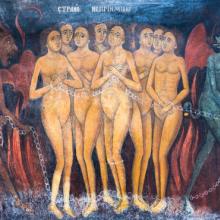afterlife
WE ARE APPROACHING the end of the liturgical year, and the texts have a thread of anticipation running through them. We are deep into the promises conveyed by the prophets and the eschatological vision cast by Jesus. The texts are inviting us to prepare ourselves for something — but what, exactly?
The last Sunday in November, in many traditions, is the Advent Sunday of hope. In biblical Greek, the verb is elpizō (“hope”), which means to wait for salvation with both joy and full confidence. When we hope, we wait not out of boredom or a lack of options but in full confidence that what we are waiting for will arrive. This is the same word used in Hebrews 11:1, “Now faith is the assurance of things hoped for, the conviction of things not seen.” The word “assurance” here can also be translated as “foundation,” as in that of a house. Faith is what anchors our hope into the ground and allows it to stand upright. Faith also often requires that we act before we see. Our hope is first materialized in our faith before it is ever materialized in our reality. Hope pushes us to walk, move, and live as if what we’ve hoped for has already arrived.
Perhaps this moment calls to us to build foundations for the futures we need in defiance of our present realities. Our texts dare us to live into new possibilities, even as our current condition offers far fewer promises.

Image via Brian A Jackson/Shutterstock
Aside from Universalists, most Christian traditions contain the doctrine of judgment, although the particulars of how that judgment is carried out varies along a spectrum. Whether it is actual physical torture for all eternity or some sort of separation from God, whether there’s purgatory or a second chance post mortem, there exists a form of judgment within the systems of Christian faith.
Good parenting sensibilities tell us we shouldn’t shy away from difficult truths, and although we try to be age-appropriate, we are obligated to share even the most unpalatable aspect of the Christian faith with our kids. The problem is: children don’t yet have the emotional maturity and logical capability to process a belief in eternal punishment. Their budding minds can’t reason through the theological necessity of judgment in a loving God. So they panic and retreat into fear. In order to coax them out of their distress we comfort them, it’s okay, Jesus will save you, just believe in Jesus.
And so it begins — even as kids develop and eventually learn the nuances of Christian life, they are bearing the invisible baggage of fear that had them gripping for Jesus.

Holding hands in a nursing home, Eduard Darchinyan / Shutterstock.com
The nursing home was quiet, which is typical for a late Sunday afternoon. I walked to the end of the hall where Grace lives in a room decorated with clown figurines that make her smile. I knocked at the doorway and announced myself. Grace was awake in bed, but upset about something.
“Oh, Joe! Come in! Can you do me a favor? I’ve lost something and could use your help finding it.”
Grace (not her actual name; I have to change it because of privacy laws) once had bright red hair that fit her personality. The red is gone now; her hair turned a pretty, cottony white after chemotherapy.
And today, something else was missing.
“I can’t find my left boob,” she said. “Would you be a dear and look around for it?”
MANY PEOPLE HAVE been given a very tame and uninteresting version of Jesus. He was a nice, quiet, gentle, perhaps somewhat fragile guy on whose lap children liked to sit. He walked around in flowing robes in pastel colors, freshly washed and pressed, holding a small sheep in one arm and raising the other as if hailing a taxi. Or he was like an “x” or “n”—an abstract part of a mathematical equation, not important primarily because of what he said or how he lived, but only because he filled a role in a cosmic calculus of damnation and forgiveness.
The real Jesus was far more complex and interesting than any of these caricatures. And nowhere was he more defiant, subversive, courageous, and creative than when he took the language of fire and brimstone from his greatest critics and used it for a very different purpose.
The idea of hell entered Jewish thought rather late. In Jesus’ day, as in our own, more traditional Jews—especially those of the Sadducee party—had little to say about the afterlife, about miracles, about angels and the like. Their focus was on this life and on how to be good, just, and successful human beings within it. More liberal Jews—especially of the Pharisee party—had welcomed ideas on the afterlife from neighboring cultures and religions, especially the Persians.
To the north and east in Mesopotamia, people believed that the souls of the dead migrated to an underworld whose geography resembled an ancient walled city. Good and evil, high-born and lowly, all descended to this shadowy, scary, dark, inescapable realm. For the Egyptians to the south, the newly departed faced a ritual trial of judgment. Bad people who failed the test were then devoured by a crocodile-headed deity, and good people who passed the test settled in the land beyond the sunset.
Yesterday, I discussed some of the historical bases for our contemporary understanding of Satan. Today, I’ll consider how hell evolved as part of the Christian faith.
In Old Testament scripture, the resting place for the dead is called Sheol. While some believe this is the same as hell, there are indications to the contrary. In the ancient Jewish tradition, Sheol is a place of rest for both righteous and wicked, with no distinction.
Not everyone is happy about it either.
In the third chapter of Malachi, the prophet recognizes the consternation of faithful Jews who are frustrated that the wicked share the same fate. In Ecclesiastes, the priest Koheleth claims that serving God is vanity. For him, the fact that the righteous are treated the same as the wicked and vice-versa should be a call to eat, drink and be merry.
With respect to any relationship between Satan in the Old Testament and Sheol, there is none.
Quantum Theory is still in its relative infancy within the entire discipline of science, although it finds its roots as far back as Plato and Descartes. But if some of the notions being pursued by contemporary scientists prove true, it may result in a convergence of science, art, philosophy, and even religion that the world never imagined possible.
I’ll admit from the start that investigating the literature for this particular article literally made my head hurt. To fully conceive of all that is discussed and examined in Quantum Theory takes a scientific sophistication that I lack. But fortunately there are some out there who are trying to make these complex ideas more digestible, without a string of letters after our names.
One such scientist is Stuart Hameroff, Professor Emeritus at the Department of Anesthesiology and Psychology and the Director of the Center for Consciousness Studies at the University of Arizona. To distill a very complex idea down into a few words, the general consensus in science is that consciousness can be attributed to computations conducted within the neurological networks in the brain. Basically, all consciousness can be explained by algorithms, which makes our brains essentially like big, highly sophisticated computers. There are some limitations thus far to this perspective, such as how such algorithms account for things like aesthetic experience, love, and even our sense of smell. Researchers in the area of Artificial Intelligence believe that discovering the algorithmic bases for such phenomena can lead to the construction (given the necessary technology) of an artificial human brain.
Jesus said to them, Very truly, I tell you, whoever believes has eternal life. I am the bread of life. - John 6:47-48
When I was in my 20s and totally out of control and pretty much estranged from my conservative Christian parents I used to joke about how my mom would try and guilt me into connecting with them more often by saying in her Kentucky accent “Nadia, the least you could do is come visit us more often … since we won’t be spending eternity together." Which made me wonder if the church she went to realized that the promise of spending eternity with my mom and her friends wasn’t exactly the best-selling point. At least not for a 21 year old.*
But that’s kind of what I was taught: that being a Christian was all about where you will spend eternity after you die – kind of like purchasing a life-insurance plan for the hereafter. And if you manage to be good enough here on earth then when you die you get to go to heaven and be like the spiritual 1 percent for eternity and live in big mansions with Jesus and wear awesome jewels and walk streets of gold.
Which made it sound like eternal life is basically about getting to live like Liberace Forever.
Funeral services will be held today for the six Sikhs killed at a Wisconsin temple last Sunday. The bodies of the deceased will later be cremated — but their souls will live on, Sikh tradition teaches.
Sikh scriptures don't dwell on what happens after death. Instead, the faith focuses on earthly duties, such as honoring God, performing charity and promoting justice.
"The afterlife is not a primary concern," said Gurinder Singh Mann, a religious studies professor at the University of California-Santa Barbara. "It's a very life-affirming belief system."
Still, like many religions, Sikhism includes intimations of immortality.
Founded in 15th-century India, Sikhism was born in the same cradle as Hinduism and Buddhism, both of which posit reincarnation. Like those faiths, Sikhism teaches that the goal is to escape from the cycle of death and rebirth.
But unlike Hindus and Buddhists, Sikhs believe that humans can't liberate themselves through meditation and virtuous living — only God's grace offers freedom from rebirth.
"We don't think that, 'Well, I've done these wonderful things, I get a ticket to heaven,'" said Mann. "That's a divine decision."
Raymond Moody has spent nearly 40 years looking forward, trying to understand what happens when people die. That pursuit led to the publication of "Life After Life" in 1975, a seminal collection that actually coined the term "near-death experience."
But in his new memoir, "Paranormal: My Life in Pursuit of the Afterlife," the 67-year-old Moody instead looks back, reflecting on his fascination with death, the effect of his life's work, and trying to figure out what it's all meant.
One key revelation: despite his frustrations with some religious and New Age interpretations of his work, and the fact that he does not practice a religion, the psychologist and philosopher who grew up the son of an agnostic surgeon says he has "woken up to God."
"I'm finding out as I'm aging that I am in love with the world. And I look right now, as we speak together, out my window in my studio and I see my trees and my beautiful, beautiful maples that are hundreds of years old, they're beautiful. And you see I can see how beautiful they are. I can take time to see how beautiful they are."




